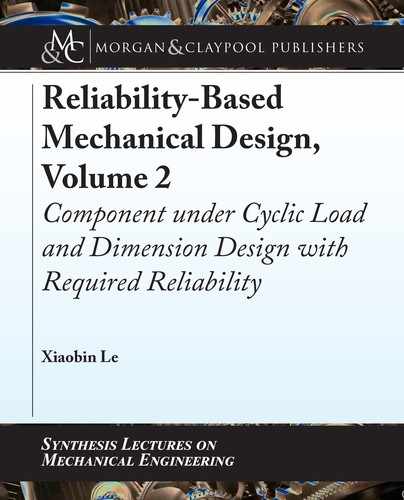
2.9. THE PROBABILISTIC FATIGUE DAMAGE THEORY (THE K-D MODEL) 79
Equation (2.79) can be directly used in the limit state function for the reliability calcula-
tion. We can also typically assume that the component fatigue strength index K will have the
same type of distribution, that is, a lognormal distribution, as that for material fatigue strength
index K
0
. We can use the following equations to calculate the log mean
ln K
and the log stan-
dard deviation
ln K
of the component fatigue strength index K:
ln K
D m ln
k
a
k
b
k
c
C
ln K0
(2.80)
ln K
D
v
u
u
t
m
2
"
k
a
k
a
2
C
k
c
k
c
2
#
C
.
ln K0
/
2
; (2.81)
where
k
a
and
k
a
are the mean and the standard deviation of the normally distributed k
a
.
k
c
and
k
c
are the mean and the standard deviation of the normally distributed k
c
. k
b
is treated as
a deterministic value. eir calculations have been discussed in Section 2.4.
e component fatigue strength index K has three distribution parameters. e slope of
the traditional S-N curve for K will be the same as that for K
0
. e component fatigue strength
index K is still a log-normally distributed random variable. Its log mean and log standard devi-
ation will be calculated per Equations (2.80) and (2.81). e three distribution parameters for
the component fatigue strength index K are listed in Table 2.36.
Table 2.36: e component fatigue strength index K with three distribution parameters
Slope of the Traditional S-N
Curve
Log-normally Distributed K
Log Mean The Log Standard Deviation
m μ
lnK
σ
lnK
2.9.4 THE COMPONENT FATIGUE DAMAGE INDEX D
After the definition of the component fatigue strength index K and its calculation equations
are explained, we can define the component fatigue damage index and its calculation equation
accordingly.
e component fatigue damage index is an indirect measurement of the component fatigue
damage under cyclic loading, is linearly accumulated fatigue damage by each cycle of cyclic
stress and can be calculated by cyclic loading per Equation (2.82). Based on the definition and
the calculation Equation (2.79) for the component fatigue strength index
K
, the fatigue damage
index D of a component is calculated by the following Equation (2.82):
D D
L
X
iD1
n
Li
K
f
ai
m
; (2.82)

80 2. RELIABILITY OF A COMPONENT UNDER CYCLIC LOAD
where L is the number of different cyclic loading levels and m is a material fatigue property and
is the slope of the traditional S-N curve. m is determined per Equation (2.74). K
f
is the fatigue
stress concentration factor on the component critical section, which has been discussed and can
be calculated per Equations (2.22)–(2.25) in Section 2.6. n
Li
is the number of cycles of the ith
cyclic loading stress level
ai
.
ai
is an equivalent fully reversed cyclic stress amplitude and can
be calculated by the following equation:
ai
D
8
ˆ
ˆ
ˆ
ˆ
<
ˆ
ˆ
ˆ
ˆ
:
a
for a fully reversed cyclic stress
a
m
0 of non-zero mean cyclic stress
a
S
u
.
S
u
m
/
m
> 0 of non-zero mean cyclic stress;
(2.83)
where .
a
;
m
/ are the stress amplitude and the mean stress of cyclic stress. S
u
is the ultimate
material strength. Equation (2.83) is based on the modified Goodman approach for the consid-
eration of the effect of mean stress in cyclic stress.
n
Li
or
ai
can be a constant value or a distributed random variable, which is defined by the
provided cyclic loading spectrum.
Following are the equations for calculating component fatigue damage per given cyclic
spectrum.
For model #1, model #2, and model #3 cyclic loading spectrum .
a
; n
L
/, the component
fatigue damage due to the cyclic loading spectrums is:
D D n
L
K
f
a
m
; (2.84)
where K
f
and m have the same meaning as those in Equation (2.82). For model #1, n
L
is
a constant number of cycles and
a
is the fully reversed constant cyclic stress amplitude. For
the model #2, n
L
is a distributed number of cycles and
a
is the fully reversed constant cyclic
stress amplitude. For model #3, n
L
is a constant number of cycles and
a
is the fully reversed
distributed cyclic stress amplitude.
For model #4, model #5, and model #6 cyclic loading spectrum .
ai
; n
Li
; i D 1; 2; : : : ; L/,
the component fatigue damage due to the cyclic loading spectrums is calculated per Equa-
tion (2.82) and repeated here as Equation (2.85):
D D
L
X
iD1
n
Li
K
f
ai
m
; (2.85)
where K
f
, m, and L have the same meaning as those in Equation (2.82). For model #4, n
Li
is a
constant number of cycles and
ai
is the fully reversed constant cyclic stress amplitude at the i th
cyclic stress level. For model #5, n
Li
is a distributed number of cycles and
ai
is the fully reversed
constant cyclic stress amplitude at the ith cyclic stress level. For model #6, n
Li
is a constant
number of cycles and
ai
is a distributed fully reversed constant cyclic stress amplitude at the ith
cyclic stress level.
..................Content has been hidden....................
You can't read the all page of ebook, please click here login for view all page.
